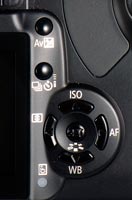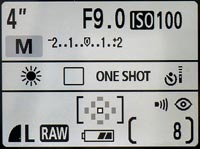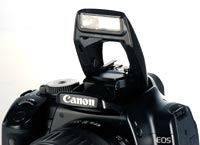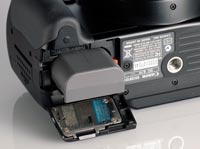Canon EOS 400D Review
(also called the Canon Digital Rebel XTi)
Date: December 4th 2006
Author: Michael Roscoe
Leave a Comment about this Review
|
Ease of Use
It's a case of playing 'Spot the difference' between the look of the new Canon EOS 400D and its predecessor the 350D. Canon has changed very little in the 400D's styling. It still has the same compact proportions of the older model and from the front there is only the nametag that signals any alteration at all. A closer inspection reveals a few subtle touches including a black shutter button and four-way controller keys, but the most obvious difference is the larger 2.5-inch LCD screen that replaces the dual info panel and LCD that were featured on the 350D. The plastic outer shell has a more refined finish and it is certainly is solid enough for an entry-level DSLR.
Holding the camera can be fiddly because the 400D's comparatively small body size means that as the grip isn't particularly deep and people with large hands (like me) may find that their little finger has nowhere to go. The 400D's start-up time is almost instantaneous and ready to shoot without any noticeable delay, which is vital for capturing those split-second, decisive moments. The straightforward layout of the Canon pays dividends when you are in a hurry. Most of the 400D's buttons are located logically on the rear of the camera. It offers quick access to the ISO, Auto Focus, White Balance and metering mode via its circular four-way controller. Aperture and shutter speed settings can be easily adjusted with thumb and index finger on the well-positioned dials. The Canon 400D's optical viewfinder is simple to focus but there is no live preview on the LCD screen, unlike the Olympus E330.
Further access to the camera's set-ups can be obtained through the menu system. Canon's simple interface displays five tabs that are easily negotiated using their four-way controller. Users have an impressive choice of eight different image quality modes and there are also useful tools like a red-eye reduction option and the usual custom white balance option and flash exposure compensation. Notable omissions from the 400D menu system are the in-camera editing and creative effects as featured on competitor models like the Nikon D80.
| Four-way Controller | LCD Screen |
 |
 |
Like most entry-level DSLRs the 400D provides a number of auto shooting modes including portrait, landscape, sports and night shooting choices. All of these functions performed adequately in all aspects, apart from the macro mode that did not come near to offering a true 1:1 reproduction. There are, of course, manual and semi-automatic modes for users who want more advanced exposure control. Canon refers to these advanced operations as the 'creative zone' and provides all the normal settings including Program, Aperture and Shutter Priority and the full manual mode.
Additionally, they provide the 'A-DEP' (Automatic Depth of Field) function that gives a wider depth of field between a near and far subject. Once the camera is in the 'creative zone' users can adjust the ISO setting into one of five positions from 100 to 1600 which is more than adequate for most lighting conditions. The 400D also offers a good range of three Auto focus modes (One Shot, AI Focus and AI Servo) and users will discover a useful 9-point AF system, which is the same as the Canon EOS 30D. There are six preset, auto and custom white balance options, but while there are three metering modes Canon have left out a Spot choice, which would have been a useful addition.
Once in action, the Canon 400D offers some impressive performance for a camera in its class. The camera was tested with a 1Gb Lexar 80x CF card, set to capture high-resolution JPEGs and adjusted to its continuous shooting drive mode. It shot captures with no noticeable shutter lag and continuously fired off three frames every second until the CF card was full. A tougher task for the 400D was shooting RAW and JPEG files simultaneously. Here it pumped out 11 shots in rapid succession until the buffer filled up.
| Pop-up Flash | Battery Compartment |
 |
 |
The new, larger LCD screen gives a good, clear view of captured images but it is best to look at the screen at a 90-degree angle for the most accurate feedback on a picture's exposure and color reproduction. More information can be seen on the LCD after pressing the DISP. button, which brings up an image histogram and all the shooting Exif data, including shutter speed and the time and date it was captured. It is simple to get a closer look at an image as users can zoom in up to 15 times, and it is also possible to view pictures in a set of nine contact sheet.
Processing the camera's RAW files can be achieved by using the Canon bundled software which includes 'Digital Photo Professional' for more advanced processing with compatibility to colour management systems. This straightforward, high speed, processing package performs extremely well and it is worth noting that, unlike their closest competitors Nikon, they don't charge extra for it, thus making the 400D comparatively better value.
The 400D is a very easy to use model that offers a performance good enough to satisfy beginners and enthusiasts alike. Snap-happy users will find that the lithium-ion battery provides ample power for over a day of intensive shooting and its ergonomic, compact design will appeal to travel photographers or space conscious users. From the outside it may seem as though there is not much difference between this camera and the older 350D model, but nevertheless, Canon have made some useful alterations including a long awaited sensor cleaning system to 'reduce, repel and remove' dust, plus the increased AF points, LCD size and megapixel count.
|
![]() PhotographyBLOG
is a member of the DIWA
organisation. Our test results for the Canon EOS 400D have
been submitted to DIWA
for comparison with test results for different samples of
the same camera model supplied by other DIWA
member sites.
PhotographyBLOG
is a member of the DIWA
organisation. Our test results for the Canon EOS 400D have
been submitted to DIWA
for comparison with test results for different samples of
the same camera model supplied by other DIWA
member sites.
